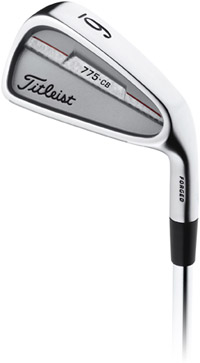 Titleist is undeniably one of the leaders in irons for better players. Since going to an all-forged irons lineup a couple years ago, the company introduced several blade, muscle-back, and cavity-forged irons that have devoted followers.
Titleist is undeniably one of the leaders in irons for better players. Since going to an all-forged irons lineup a couple years ago, the company introduced several blade, muscle-back, and cavity-forged irons that have devoted followers.
But the better-player irons market is relatively small, and the big money is in the bigger game-improvement irons. Titleist’s latest attempt to muscle in on the Callaways and TaylorMades in the game-improvement iron category is with the Forged 775.CB iron, which hit golf shops this spring. I had the chance to try a set to see how these new irons stack up against other irons for higher handicappers.
Seeing Titleist irons in my golf bag gives me a warm feeling, even if it’s the glow of nostalgia. After playing tiny forged blades while learning the game, my first cavity back irons were a great set of Titleist DCI Golds that I played for several years. Those cast stainless steel irons were plenty forgiving, but still had a crisp design that said “I’m a serious golfer.” After the follow up to the DCI Black (less offset) and Gold irons, the DCI Oversize, Titleist ceded the high-handicapper iron market to sister brand Cobra.
I’ve played several different sets of irons since then, but I always keep an eye on Titleist to see if they might bring out a mid-handicapper iron that takes up where the DCI Golds left off – a design that has some forgiveness built in, but also enables a player of more modest skill to still do a little shot-making. So I was excited to see Titleist announce the Forged 775.CB irons earlier this year. They sounded like a good blend of technology and playability, and I was lucky enough to play almost 10 rounds with the 775.CBs. I was curious to see if the new sticks would live up to my memories of the DCI Gold irons.
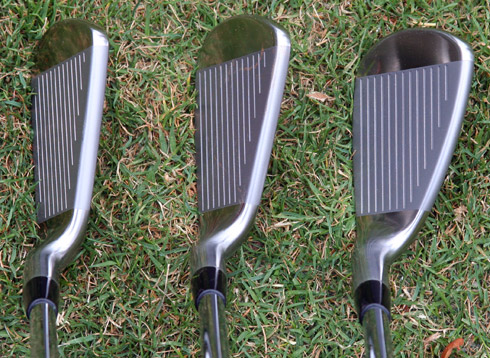
The Forged 775.CB irons progress from large clubheads with pronounced offset in the long irons to more traditional-sized heads in the short irons.
Design and Technology
The 775.CB irons have different designs for the long irons and mid-to-short irons. While the 6-iron through the 50° gap wedge are one-piece forged cavity backs, the 3-, 4- and 5-irons are all oversized multi-material designs. The long irons have a forged stainless steel body that accounts for almost 80% of the clubhead weight for a high degree of perimeter weighting and forgiveness. A thin face insert is used along with a forged aluminum bar across the back of the face. This bar – which is anodized a deep red and really stands out – is meant to dampen vibration and reinforce the thin face insert.
The long irons in the 775.CB set also have a heaping helping of offset. The 3-iron has more than double the offset of the 695MB irons, or much more than you’d ever expect to see on a Titleist iron (more on that below). The amount of offset is in line with what other game-improvement irons sport, but it looks more pronounced because of the square-toe, high-heel design that Titleist uses in all its irons. The designers at Titleist are clearly skilled craftsmen, but even they seem to have trouble making a club that has both offset and a sleek design (a pretty common problem in iron design).
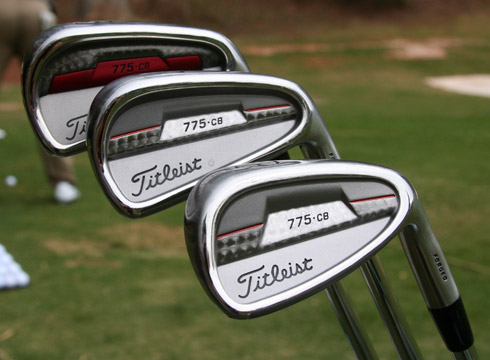
The 3-, 4- and 5-irons have a red aluminum bar in the cavity, and each iron in the 775.CB set has what look like milling mark “swirls.”
The 3- and 4-iron shafts are also longer than standard (half an inch in the 3-iron, a quarter-inch in the 4-iron) to increase clubhead speed and help get the ball airborne more easily. There’s no arguing the physics of this design decision, as a longer shaft will equal more speed. But it can also decrease accuracy, which is a problem most people have with their long irons to begin with. It’s good to see Titleist putting extra technology into long irons, but I wonder how many golfers who use the 775.CB irons will replace the longer irons with hybrids anyway.
The mid and short irons in 775.CB set are more compact than the long irons, and they feature progressively less offset as the loft increases. The lofts are fairly strong – the pitching wedge is 45°, and a 50° gap wedge is available — because the irons have a very low center of gravity and launch the ball quite high. Strengthening the lofts keeps the ball flight in line with what golfers expect from each numbered club.
Esthetically, the 775.CB irons are unlike anything else in Titleist’s lineup. The red color of the aluminum bar used in the long irons is carried over to the mid and short irons as a thin red line of paint through the center of the cavity. The cavity of each iron also has a area that has small metallic swirls that look like milling marks. This gives the irons a busy look that won’t appeal to a blade user, but is in line with the “visible technology” design cues used on most other game-improvement irons.
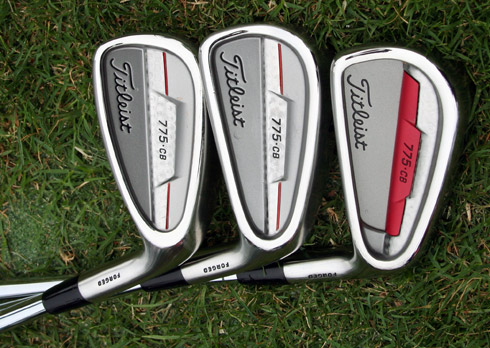
The 775.CBs strike an esthetic balance between the visible technology of game-improvement irons and the understated look of Titleist’s other forged irons.
I liked the looks of the 775.CB, especially how the short irons set up at address. The irons look good in the bag and the forged stainless steel holds up well to regular use, though the red finish on the aluminum bar of the long irons was prone to scratching.
The standard shaft for the 775.CB irons is the Nippon NS Pro 100, which is a mid-weight steel shaft. I tested the irons with True Temper Dynamic Gold R300 steel shafts, and Titleist’s 3970 lightweight graphite shafts are also an option – along with other popular custom shafts like the Project X, various Rifle models and the True Temper Dynamic Gold SL. The standard grips are Golf Pride Tour Velvet Cord models with the Titleist logo faced toward the underside of the club, just like the big boys on tour do it.
Feel and Performance
Every iron in Titleist’s current lineup is forged, though the 775.CB is forged from stainless steel instead of carbon steel like the rest of Titleist’s irons (with the exception of the 735.CM irons, which are available in forged stainless and carbon steel flavors). The forged stainless steel used in the 775.CB irons is not as soft as the carbon steel generally used in forgings, but it is also more durable and resists rusting. The buttery soft feel of forged carbon steel isn’t a selling point for the higher-handicap player who is likely to use the 775.CB, but I found the irons to feel solid and fairly soft. Not as soft as the 690.CB irons I have, but softer than investment cast stainless steel irons. And while the 775.CB irons don’t punish miss-hits with the harsh sting that forged blades impart, they do give you plenty of feedback at impact so you can immediately tell if you’ve missed the center of the clubface.
Performance-wise, the 775.CB is definitely aimed at the 15-plus handicapper. The generous offset of the long irons does keep them from going right, but I had trouble keeping them from going left without adjusting my swing. When I set up to hit a cut, I got a high, straight ball flight from the long irons, though I lost a little distance. The mid and short irons didn’t require as much correction, but they still wanted to go a little left for me. While I found the long irons a little short, the short irons were actually almost a club longer than what I’m used to from strong-lofted irons. Again, this says to me that the 775.CB irons were designed for someone who has trouble squaring the clubhead at impact and tends to slice the ball, so the weight is biased toward the heel to close the face through the impact zone.
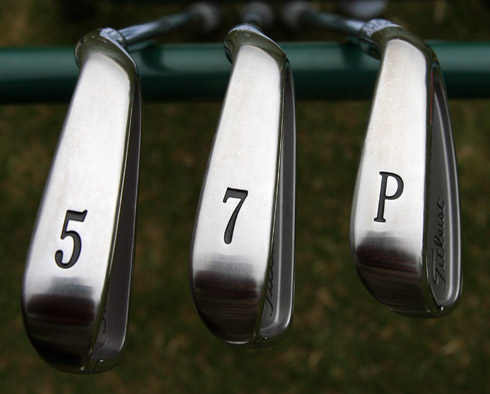
The heel-to-toe length of the 775.CB irons decreases quite a bit from the long to short irons. The sole design makes for crisp contact with the turf.
The weight distribution in the short irons did help control the ball flight very nicely. The 775.CB short irons and wedges responded ably on knockdown shots and short-game shots around the greens. The soles are also relatively narrow for a game-improvement iron, which increased the versatility of the 775.CBs throughout the set. These clubs were equally at home hitting from a tight fairway lie or powering a ball out of deeper rough.
Conclusion
The Titleist Forged 775.CB irons are designed as a point-and-shoot iron, and they would make an excellent choice for a 15-plus handicapper who needs help hitting the ball longer and straighter. And for a high handicap golfer who wants to be able to say he uses Titleist irons just like so many PGA Tour players, the 775.CBs are the only way to go. I think the 775.CBs would be a good fit for golfers who play Callaway Big Berthas, Ping G5, or TaylorMade r7 XD irons. These are the best high-handicapper irons Titleist has offered since the DCI Oversize.
The leap from the 695CB and 735.CM irons to the 775.CB irons in Titleist’s iron lineup is a big hop, however. The former are great for single-digit handicappers, and the latter will perform well for someone with a handicap in the teens. I’m playing to about a 10 these days, and I’m right in between the two types of Titleist irons. I think there’s a market out there for a Titleist iron that fits in with “tour” versions of game-improvement irons like the Callaway X-18, Cleveland CG4, and TaylorMade rac LT. But golfers who fit into those products would probably be better off playing up to the 695CB or 735.CM irons if they wanted to make the switch to Titleist.
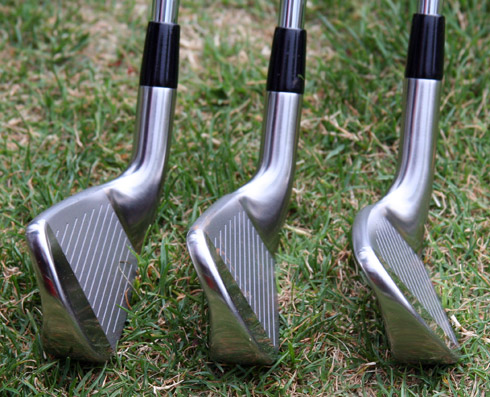
The offset of the long irons (left) in the 775.CB set is more than double some other Titleist irons, while the short irons are comparable to other irons in the company’s lineup.
I’d be geeked if Titleist came out with a tweener set of forged irons that was somewhere between the 735.CM and the 775.CB. In fact, I’ll start the rough design work. Let’s call them the 755.CB irons (wink wink). Start with the 775.CB short irons and drop about 33 percent of the offset from each iron, then make the long irons single-material designs to match the look/feel of the short irons. Voilà! A set of irons for the 6-10 handicapper. Hmmm, not sure if it makes marketing sense to add a fifth set of irons to the lineup for such a small segment of the market… but I know I’d be waiting to demo a set at my golf shop.
Back on this plane of reality, the 775.CB irons didn’t turn out to be the second coming of the DCI Gold irons that I’d hoped for. But high-handicap golfers can rejoice that Titleist has made a set of irons that will offer them both game-improvement performance and the allure of playing Titleist forged irons.
Titleist Forged 775.CB irons have a street price of $750 for eight clubs (4-iron through gap wedge) with NS 100 Pro steel shafts. The same 8-club set with Aldila 3970 graphite shafts will run you $879. If you want to add the 3-iron, it will cost you $100 for steel and $110 for graphite.
I purchased a set of custom fitted Titleist 775CB’s 5 weeks ago, the change in my game was immediate and the result = 5 shots off the handicap in 5 weeks. Thanks Titleist.
I find your reviews always interesting and very helpful. However, in discussing the 775CBs as game improvement clubs, I believe your review may be somewhat misleading in the following way: in my opinion, these clubs are not nearly as game improvement as the Callaway Hawkeye VFT irons I owned. The Callaway clubs’ topline, as well as the sole , is much thicker, and there appears to be more offset ( especially in the shorter irons ). I think this observation holds true when one compares other clubs to the 775CBs, such as the Ping G5s, the Callaway Big Berthas, the TaylorMade RAC OS2s, the Cobra 3400 I/XHs, as well as others. I don’t mean to suggest that the 775s are players’ clubs, for they are certainly not in the same category as the 735s, much less the 695s. I do suggest that because they are thinner ( which you do point out ) and more traditional in appearance and in play than some of the aforementioned clubs and, because they are progressive in size ( again, which you stated ) unlike many game improvement irons, the 775s are not the typical game improvement set one might ordinarily consider or encounter at a golf shop. I do agree that the red bar on the long irons is fragile: my 5 iron red bar bears a chip that seemed to appear from nowhere after only 4 weeks of play. I would offer that these irons fall between the more game improvement irons such as some of those made by Ping, Callaway, TaylorMade, Cobra, and others, and those irons such as the Titleist 735s. I hope one day to have a swing repeatable, fluid and skillfull enough to allow me to play irons such as the 735s, or even the 695s. Until then, I will content myself with moving from the really thick Callaway VFTs to a more elegant, slimmer iron. Have my scores improved in the 11 weeks I’ve owned the 775s? Not radically. I have shot scores in the mid eighties more consistently than before and that fact alone has been a source of pleasure. Finally, I must say that I really like the 8, 9, Pitching and Gap wedges the most. Being able to hit the most traditional irons in the set the best gives me confidence that I may be on the track toward improving my game. One more comment about your review, Donald : I particularly appreciate the critical nature of it, as well as those reviews by Erik. The reviews on this site seem to me more in depth and not as fatuous or as sycophantic as those found in some other sites and magazines. Thank you for the good work.
Shortgame85: Thanks for the well-thought comment and kind words. I agree, a Titleist game-improvement iron will always be a bit less extreme than a super-game-improvement iron like the VFTs (one of the easiest irons I’ve ever hit, BTW). I agree that the short irons are excellent in the 775.CBs. I just wish the long irons didn’t have so much offset, because to me there was a disconnect between the 3-6 irons and the 7-PW. But I’m glad the irons work so well for you, and I hope you continue to like them.
What clubs would you recommend for a 6 handicapper?
i’m 29 years old, and have handycap 5 in golf course.
my driver distance is 250 yards average…
i’d like to ask which iron i should use for a better stroke in the future… thanks for answering my question ! i’m sorry that my english not very well…
I just want to thank you for your nice and very informative article!!! Very few people can write and describe golf products as you did.
😉 Great review Donald. Very informative. Pics are also very helpfull. Good work – thank you.
First visit to the site but not my last…
Any feedback on this would be appreciated. I shoot in the low 90’s, but used to be in the upper 80’s before trying to make some swing adjustments. I recently hit the 775.CB 6-iron at a range and loved the feel. I am thinking about making the purchase, but wanted to know if you think there are other irons out there I should try (didn’t know the pffset progressed so much). The club seemed to be very soft at impact and the trajectory was great. Biggest improvement was my ball speed on current 6-iron was 109 mph and on off the face of the 775 it was 129 mph.
😆 A good review but I don’t think they are for 15+ handicappers.I was playing Mizuno MP30’s with a S300 shaft which was now far too stiff for my ageing bones.I am a higher single figure handicapper now and have been as low as 4.I asked my local custom fitting centre to fit me with a set of irons that would allow me to get the most from my game.I had no preconceived ideas.The titleist 755 CB with graphite shaft came out tops.I was a good 20yards further with the 6 iron alone.I’m looking forward to playing them.
I had a comprehensive fitting session today with a Titleist Master Fitter and absolutely loved the 775’s. I was previously playing Mizuno MP-30’s as well but after a nearly 2 year break from the game I did not have the swing necessary to enjoy the MP-30’s any longer (shooting high 80’s to low 90’s now). Recognizing that I also do not have the time to practice and play as much as I used to (or would like to for that matter) I made the choice for a club that was more forgiving. Granted, my time hitting these clubs was limited to an hour session on the range but I could tell instantly that they were perfect for me right now. I tried tons of other clubs as well – these just had it all. Look at address was pleasing to me – this includes both offset and top line. I find this important because you need to have confidence before each swing. Accuracy/repeatability was far superior to the results I was getting with the MP-30’s. This could be a function of both the forgiving qualities of the 775’s and the proper fit. Distance was also substantially greater (routinely getting 185-190yds from 6 iron which is a solid 20 yds longer than MP-30’s) but I don’t think this should be a major criteria for iron purchases. In my opinion, distance control should be weighed more heavily and this is hard for me to tell without more time with the clubs. Feel is absolutely terrific. If you are a player of similar ability and have never played forged clubs before you should at least give them a demo. The stainless steel forging did not feel remarkably different to the softer carbon steel of the Mizunos. Finally, I like that you can get a gap wedge at 50 degrees with the same reasonably compact cavity back design. I find this to be a more forgiving and reliable option for full wedge shots from roughly 100yds than traditional Vokey/Cleveland/Mizuno wedges which I only use for chipping and touch shots around the green. I hope that this review somehow helps others in their decision process.
I bought a set of used 775’s and tried them after they appeared as Golf Magazine’s No#1 game improvement club and hitting a borrowed 6 iron on the range.
The set I bought was used and had Dynamic Gold stiff shafts instead of the lighter NSP 100’s that come stock and I think that was a mistake on my part as I found them to be too heavy with those shafts and had a harder time controling them from the turf as result. Tee shots were fine. My experience with “stock shafts” may have been a bit different so take the below with a proverbial grain of salt.
My experience with them was that they would be great for a new player (with stock shafts) that had a problem slicing as they definitely are forgiving and have plenty of offset and close the club face with ease. However, for me I had problems with every ball I hit going left in a draw This was most pronounced with the longer irons particularly the 4 iron.
Shot’s off the toe were generous in their distance and line and gave me far better then I deserved. And even fat shots went a mile, but in the end I swapped these for a set of 755’s which I can hit straight and find far more playable both off the tee and the turf. YMMV.
i am currently playing some crappy spalding irons and have been for years. after buying a 905r and owning a 975f for a while and hitting them well with a boring draw, i was wondering if i was ready to step up to some titleist irons. i usually shoot mid 80’s and recently posted my lowest score ever (81). i was thinking that titleist were only for players and shot shapers that were scratch handicap, then the 775 appeared. now im torn between mizuno mx25, TM r7, or ping G5. i was even thinking of the old 804 OS as an option. any insight would be great.
Kankle J – You need to take all clubs to the range and see for yourself. I thought I was getting the 775 until I tested the mx25, R7, G5, Raptor, and X-20. Hard to tell when you have such a huge selection, but I quickly was able to filter out the mx25, X-20 and G5 irons. They only reason I didn’t continue hitting the Raptor was that I was coming out of Ping ISI’s. After feeling good with the R7 and 775’s, I took to the cage at Edwin Watts. Here I was able to see the difference on their launch monitor. I hit the 775 6-iron 173 and hit the R7 6-iron 186. I also hit the R7 consistently straighter.
thanks fran- i did end up hitting about 15 different clubs at a golf galaxy (drove the fitter crazy, lol) everything from callaway x-forged, to r7’s, to g5’s and a few mizuno models just to name a few, it was somewhat of a tie between the mx 25 but after hitting a couple in a row dead center with the 775’s i knew that was the one. the feel is crisp yet soft, with enough playability to shape shots but still forgiving. i got custom fitted and they are in the mail – i cant wait. they should arrive early september for brisk scenic courses in VT.
i am 13 years old and currently play off 13 and recently bought these irons off my local golf shop i got steel r 300 shafts which are great but as they r the light versions means that the club head feels a bit more heavy but they r really fantastic one thing t(hat i do not like the excessive amount of offset on the 5 and4 iron but they r truly fantastic. (grips that they r sold with die verry quickly
How would you compare and rate this “game improvement” iron for a mid-hcapper (15-18) to the newer but obviously much more expensive AP1s? As the 775CBs have been discontinued and there are good prices to be had, would one be better off with the 775CBs? thanks
i hav tried these clubs and i think that they r good for handicaps between 5-12.
I was fitted for Titleist 775CBs by David Corrado, the Head Golf Professional at TPC MI. These irons instantly proved to be game improvement clubs! I played to a 17 handicap before purchasing the irons. My handicap is now about a 12. These irons work well for me, but a good portion of my improvement had to do with being properly fit. I was fitted for previous irons by “knowledgeable” sales people from an area store. Mr. Corrado’s in-depth fitting session was pronouncedly different (1/2 degree flat, where others had me fitted at 2-3 degrees upright!). Now, everything fits AND works fine.
These irons are very nice. Just make sure your salesperson fits you properly.
Take it from me after golfing for 46 years. It is NOT how long you hit your 6 iron. It is how you can control the distance and direction. A consistent 150 yds with a 6 is better than 175 from a cast club. But even more important is how good is your feel when chipping under 100 yds. That feel will lower your scores the most. Sure a cast R7 will be longer than a forged 775. That means didly to your score. 75% of your iron shots will be under 100 yards. There the feel is the king. Get a forged iron for that reason alone. Does not matter if it is 775 or mizuno or nike.
I have been trying to find a set of these clubs in left handed stiff for some time now. Does anybody know any good places?
I just bought a set of 775.CB Titleist irons and tryed them out in a Womens club tournament the same day. I won 2nd place! They feel amazing! I am a 20 handicap and have just been playing over a year and a half with a womens mismatched set of ping G2 irons. I am going to love playing with these irons and am shooting for number one next month!!! 🙂
I just play golf for 11 months and mad crazy about Golf. Start with Mizuno MP37 with Dynamic Gold R300. It was going good in my game till one day I want to try the gravity irons set.
I just bought 2nd hand Titleist 775.cb with Dynamic Gold S300. I think they are more easy to hit and more distance than MP37 about 5- 10 yards. And now my handicaps down to 15
Thanks…
PS. I would rather to know what shaft is matching to my swing – Club head speed – driver = 106 – 110 mph / iron = 89 – 91 mph.
Well, the 775 cb iron set is awesome. The top line is small enough to feel as though you are playing a muscle back blade. The offset is not as dramatic as we all hear about, and I have even heard that the distance is not that great on the long irons………I hit the 4 iron consistantly 205yds, and very straight. This is a great distance and extremely accurate iron…..The set is great and I play to 6 index……….if you play golf, these will help your game……period……….I have had them all, and these are the end-all…..be-all…………….
i am a 22handy cap got set of titlest zm do you think i will be able to hit them
No way…they are forged blades which are for single digit handicaps, and you have to be pretty amazing to hit them. I’m an 8 and I can’t even hit them consistently and ball striking is one of my pluses. They are extremely unforgiving and will not help your game.
I picked up a used set of these with graphite shafts for a reasonable price as a step up from my Ram FX2 irons. They are not the newest thing on the market these days but they are very nice game improvement irons. I have only played five rounds with them but I am very pleased. I’d but them again in a heartbeat.